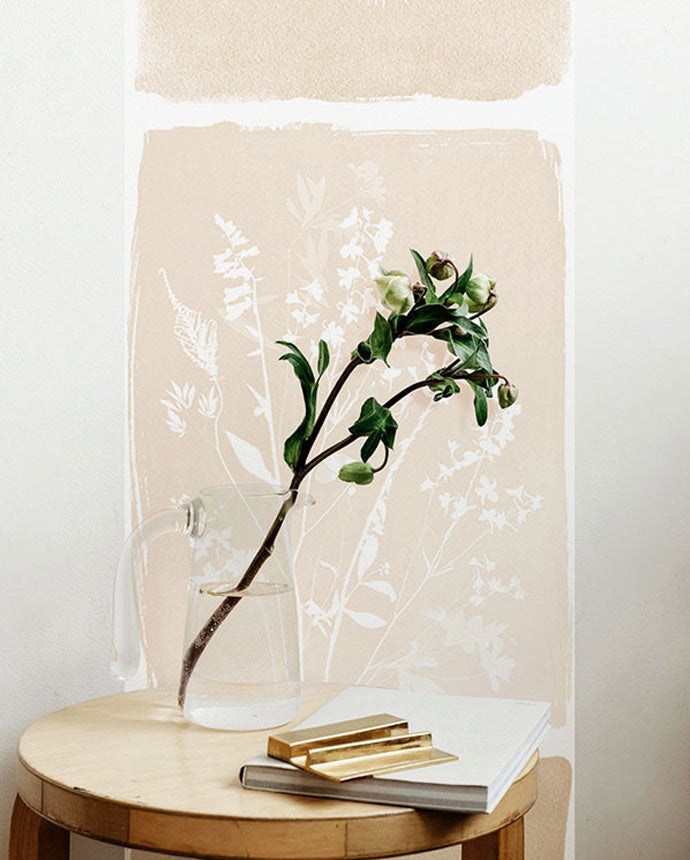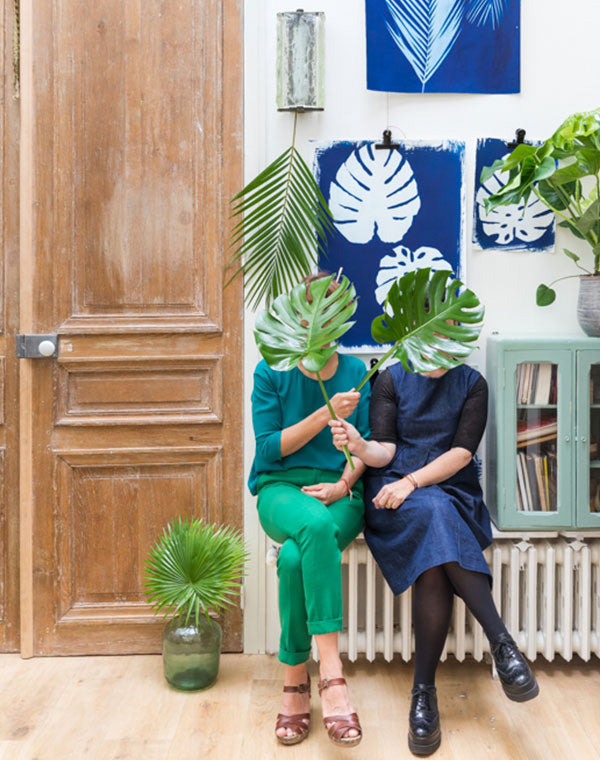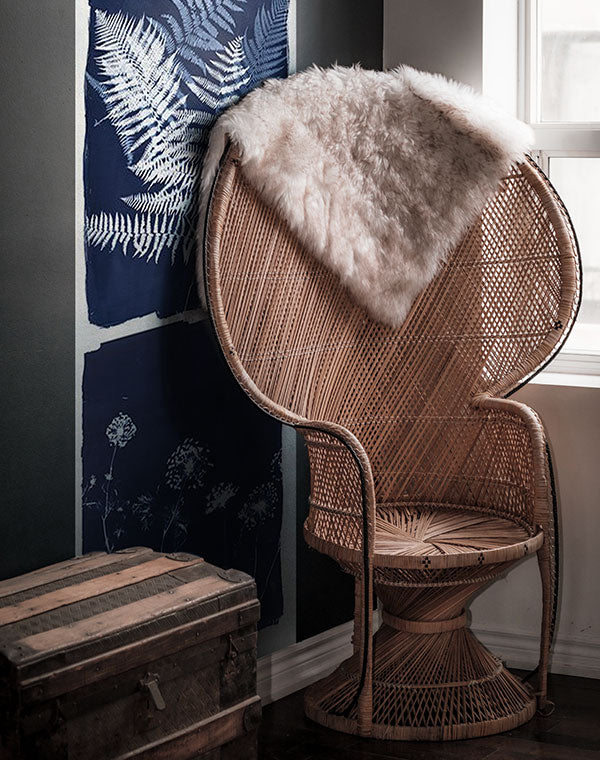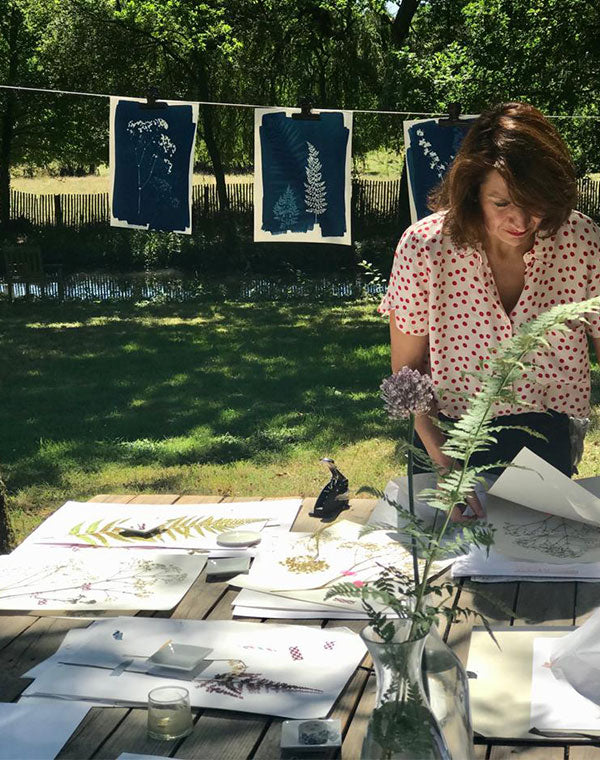
"Un Invincible Summer"… Expression of Albert Camus on the one hand, pretty French brand giving back its letters of nobility to the cyanotype herbarium on the other hand. All in all, the result is an impression of nature, an eternal sun at home. This unique technique dating from 1842 is coming back among us to dazzle our interiors. The imprints of the plant crystallize thanks to the rays of the sun. A process imbued with poetry, delicacy, combining patience and know-how.
This unique beauty of nature is immortalized and is available today with us! The cyanotype thus takes pride of place on our walls thanks to PaperMint, a French publisher of wallpapers made in France. Born from this lovely collaboration, eight strips imagined in authentic Prussian blue and timeless beige are presented exclusively at Fleux!
“In the middle of winter, I discovered within me an invincible summer.”

Can you tell us more about your background and introduce us to Invincible Summer?
For 25 years, I have been chief editor at Marie Claire Idées. But at the same time, I have always pursued projects in crafts, in publishing... I have an undeniable attraction for the handmade. For the artistic field but with a concrete dimension.
As for my career, I studied at the Ecole Supérieure Estienne des Arts et des Industries Graphiques then did the Beaux-Arts in Paris. I will qualify as an artist… with my feet on the ground!
My latest project, Invincible Summer, was born quite unexpectedly: more precisely during a trip to an island in Greece four years ago. One of my friends, an American artist, introduced me to the cyanotype technique during these holidays. A box of white powder, a few manipulations and, past the surprise, I was conquered by this forgotten technique!
From the famous quote by Albert Camus "In the middle of winter, I discovered within me an invincible summer". This is a phrase that particularly resonates with me. Even in times when everything is going badly, we have a sun within us that allows us to hold on. It is also a phrase that nicely echoes the cyanotype process. The latter is carried out during the summer season, in full sun, with a beautiful light. It's a technique that I discovered at that time as well. A technique that requires sun and water. We have a summer at home, a summer behind us and a summer ahead of us. It is, for me, a particularly solar form of poetry.

Where do you draw your inspirations from? Does your double role as editor for Marie Claire Idées allow you to nurture your artistic projects?
I've always been very curious, always wandering around galleries, museums… Everything really interests me: exhibitions, hikes, cinema… Inspiration is everywhere, without limit.
Marie and I were able to assimilate a lot of knowledge, bathe in culture through our studies. And it's something that we continue to feed into on a daily basis.
My double role at Marie Claire Idées allowed me to get to know many artists and artisans, to defend people who work with their hands. It is this sensitivity to the handmade that also guided me in my project: I wanted a virtuous brand, which was based on craftsmanship.
How did the idea for this collaboration with PaperMint come about?
At the time, we presented panoramics. Alexandra was an acquaintance of mine when I launched PaperMint. I had followed this project in particular as a journalist. It happened very naturally.
The cyanotype was born from an absolutely magnificent story. From a woman named Anna Atkins. In the 1840s, women in England were not allowed to work at the time. An orphan, Anna lives with her researcher and naturalist father. Passionate about herbariums, the botanist realizes that chemists and scientists, in particular Herschel and Talbot, are working on the process of photocopying. She uses this technique to reproduce her herbaria. She dries them and sends them to her relatives. By means of the cyanotype, several herbaria can now be created from the same plant. The cyanotype has thus recently returned to the fore. We have the impression that this is a new technique, whereas it is neither more nor less the old generation herbarium and fallen into oblivion! From the first photographic herbarium in the world, imagined almost 200 years ago! What is quite surprising is that nothing has changed, it is the same photosensitive solution technique.
When we do workshops with Marie, we prepare the papers. We use a photosensitive solution, we paint the different papers and put them to dry overnight. The next day, we isolate the papers. Place the ferns and other plant elements on the paper. By a reaction of the UV rays produced by the light of the sun and the paper coated with a photosensitive solution, the various vegetable imprints are created. UV rays do not pass where the fern has been deposited. Also, when you remove the fern and after rinsing the paper with water, the solution that was under the fern could not take on the paper. For the rest of the paper, rinsing with water causes a reaction on the paper: it turns blue and gives what is called Prussian blue. The technique is therefore quite delicate. We make everything by hand: we make our herbariums, we paint, we apply and rinse with water, we press... All of this together. Each piece is therefore unique. Handling can be more complex on very large formats, leading us to work in pairs. Everything is therefore carried out in our workshop in Paris or Sceaux. Prints are unique with the exception of scanned prints. These are included in our cyanotype image bank (small legacy of our work in publishing).
“Since the birth of Invincible Summer, we have always seen nature through the prism of the cyanotype: we look at a fern, a maple leaf, imagining its footprints… All of nature is eyeing us!”

Does this project give you the desire to express yourself on new media? Do you have the will to decline your plant universe?
Of course we are open to the idea of developing new media. We cannot carry out collaborations on our own initiative but we are open when beautiful brands or houses come to us: we can start from our digitized prints and transpose them onto clothes, scarves...
We are both very sensitive to nature. For my part, my family history is intimately linked to my work: I come from a large family of botanists and naturalists, whom I knew better for their activities as architects. Several herbariums of my family have also been entrusted to the Natural History Museum. I've always loved botanists' boards, I've always been immersed in this universe. The herbarium is for me a family heirloom. Marie also maintains a very strong relationship with nature and whenever the opportunity presents itself, always goes outside. The last word, a blue or vegetable object that has recently caught your eye? Since the birth of Invincible Summer, we have always seen nature through the prism of the cyanotype: we look at a fern, a maple leaf, imagining its footprints... Our vision has thus changed on nature: we will do so dry the bouquets of flowers that are offered to us, pick up and transpose any piece of plant that catches our eye.





